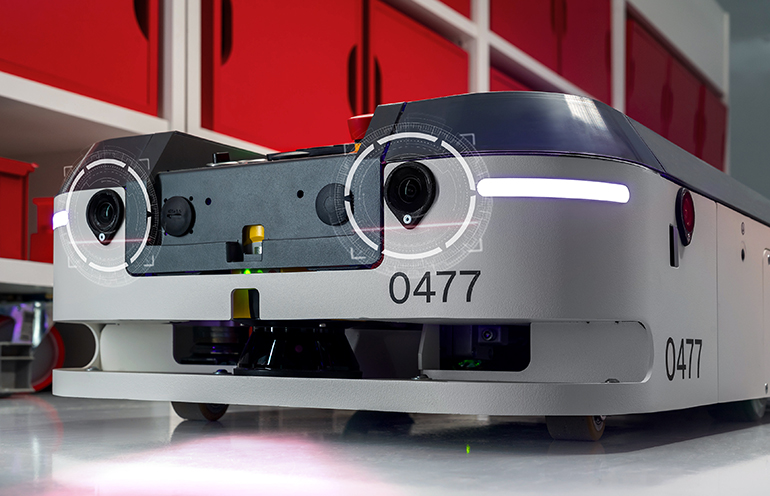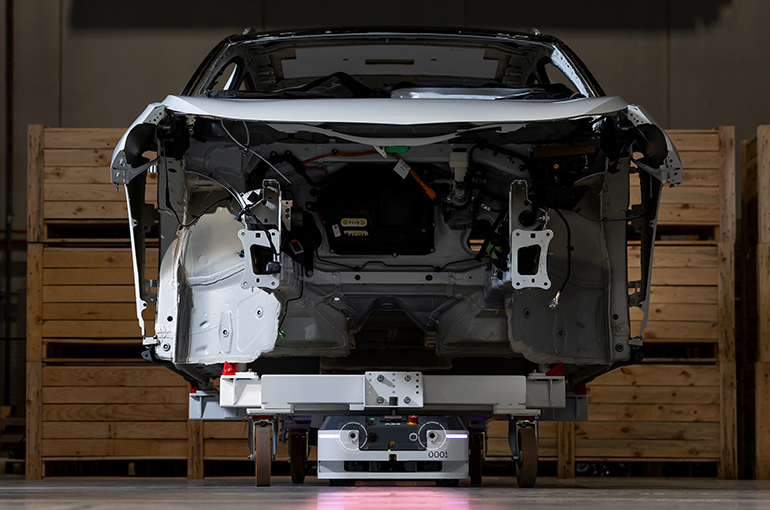|
Listen to this article  |

Sevensense said its VSLAM technology can improve mobile robot navigation. Source: ABB
After a challenging year for autonomous mobile robot, or AMR, providers, industry leaders are continuing to consolidate. ABB today announced that it has acquired Sevensense, which combines artificial intelligence and 3D vision to enable AMRs to differentiate between fixed and mobile objects in dynamic environments.
“Offering more autonomy and cognitive intelligence, ABB’s unique market-proven technology paves the way for a shift from linear production lines to dynamic networks,” stated Marc Segura, president of ABB’s Robotics Division, in a release. “Intelligent AMRs autonomously navigate to production cells, tracking stock inventory as they go and sharing this information with other robots, while collaborating safely side by side with humans.”
Spun out of ETH Zurich in 2018, Sevensense’s Visual Simultaneous Localization and Mapping (VSLAM) technology enables mobile robots to create maps for fully autonomous operations, reducing commissioning time from weeks to days. This allows AMRs to operate independently in complex factories and warehouses alongside people, it said.
A fleet can constantly update and share maps, allowing for scalability without interrupting operations and with greater flexibility than other navigation technologies, claimed the company.
Sevensense acquisition evolves from partnership
ABB has invested in innovation for more than 50 years, Segura told The Robot Report. It has partnered with universities such as ETH Zurich and built a partner ecosystem and startup accelerators to keep up with rapidly developing technologies, he said.
ABB had invested in Sevensense in 2021, the same year it acquired ASTI Mobile Robotics for $190 million. The industrial automation provider had added the startup’s VSLAM technology to its AMRs over the past few years, so why acquire it now?
“The decision to transition from partnership to ownership of Sevensense fulfills part of ABB Robotics’ investment strategy, which focuses on innovative AI solutions with the power to transform industries such as logistics and manufacturing,” said Segura. “Through ownership, we are able to fully integrate Sevensense’s pioneering navigation technology into our AMR portfolio and explore new markets and opportunities together.”
ABB did not disclose how much it paid for Sevensense.
ABB expects mobile robot demand to grow
“There is also an increasing demand for this technology from our customers,” Segura said. “ABB’s analysis estimates the market for mobile robots to grow at 20% CAGR [compound annual growth rate] through 2026, from $5.5 billion to $9.5 billion. This acquisition fortifies our position as a global leader in next-generation, AI-enabled mobile robotics and allows us to address our customers’ needs for greater flexibility and intelligence.”
ABB also cited labor shortages as a driver of demand for more flexible automation.
“This marks a significant step towards our vision of a workplace where AI-enabled robots assist people, addressing our customers’ needs for greater flexibility and intelligence amidst critical skilled-labor shortages,” stated Sami Atiya, president of ABB Robotics and Discrete Automation.
“Each mobile robot, equipped with vision and AI, scans a unique part of the building,” he said. “Collectively, these robots complement each other’s view to form a complete map, enabling them to work autonomously in a rapidly changing environment.”

Ford and Michelin trialed ABB AMRs using Sevensense VSLAM. Source: ABB
ABB sees pilots as path to multiple markets
ABB had already conducted pilot projects with customers in the automotive and logistics industries.
“In automotive, trials with Ford have resulted in efficiency gains in production sites in the U.S., and Michelin has also reported efficiency gains at its site in Spain,” said Segura. “Other automotive manufacturers will roll the technology out at sites in Finland, the U.K., and Germany.”
ABB is also looking to apply the “unprecedented combination of speed, accuracy, and payload” to other markets.
“In retail and logistics, we have found that this visual SLAM technology has made it possible for a large fashion chain to use AMRs, as they can now navigate through complex and dynamic environments, automating the company’s intralogistics,” Segura explained. “Trials have found the AMRs are particularly adept at delivering supplies upstream of a production line, handling finished goods further downstream, and carting pallets around busy factories and warehouses.”
“But this is just the beginning,” he added. “This technology will enable mobile robots to work in new sectors like healthcare and life sciences. It will lower existing entry barriers for robotics, making automation more accessible, while opening up new applications.”

ABB expects its robots using VSLAM to serve the manufacturing, logistics, and service markets. Source: ABB
AI and data to add value, says Segura
In addition to collecting data for navigation, mobile robots and AI can provide more value over time, Segura noted.
“The integration of robotics and AI creates opportunities for significant productivity gains for companies of all sizes and sectors,” he asserted. “While robots are ideal for strenuous, monotonous, repetitive, or dangerous tasks; work around the clock; and can be easily adapted to different production conditions, AI enables robots to fulfil these tasks better. Robots become more adaptive as they learn through experience, and [human] workers can devote themselves to other, higher-value tasks.”
“With Sevensense and VSLAM, we firstly acquire large amount of data through 360-degree cameras,” explained Segura. “A map is created using AI to qualify the features, and then, again using AI, we enable autonomous, flexible robust navigation that can detect humans or other obstacles and navigate around them smoothly.”
“Beyond that, we will be able to fully semantically map the environment, enabling even more intelligent and autonomous decision making,” he said. “Visual SLAM is the gateway to leverage generative AI and large language models [LLMs] in mobile robotics.”
Not only can AI and LLMs help robots move more easily, but they could also improve make them more responsive to users and operators, according to Segura.
“In the past, humans had to learn the language of robots,” he said. “Today, thanks to AI, robots will learn our language. We are already conducting first experiments in collaboration with Zhejiang University in China.”
“In the future, AI-enabled robots will eventually be able to carry out tasks using voice commands, which offers enormous advantages for small and medium-sized companies that do not have programmers in their own ranks,” he said.
“AI takes robotics to the next level, enhancing human-machine interaction [HMI], equipping robots with a wider skillset, generating insights and optimizing processes,” he said. “This lowers entry barriers for applications in various industries, making automation accessible for everyone.
ABB plans further integration of Sevensense VSLAM
ABB plans to integrate Sevensense’s technology throughout its AMR and software portfolio.
“In collaboration with Sevensense, ABB has already started to implement the Visual SLAM technology into the AMR T702V and the AMR P604V,” said Segura. “These will be followed by other AMR products incorporating VSLAM that will be rolled out in the next three years.”
ABB said that Sevensense’s approximately 35 employees will remain at its headquarters in Switzerland, and it will continue to serve customers besides ABB.
“Sevensense is part of ABB and will become a global product center for Visual SLAM AMRs, based in Zurich,” Segura told The Robot Report. “It will continue to run its business with other customers as normal, and the technology will also continue to be sold across segments including material handling, cleaning, and other service robotics fields under the product name ‘Sevensense.’”
“This is a significant moment in our shared journey, as we introduce our home-grown technology to a wider range of markets and sectors,” said Gregory Hitz, CEO of Sevensense. “ABB is the ideal home for us to continue scaling our versatile platform for 3D visual autonomy, serving OEMs across the automated material handling and service robotics industries. Together, we will redefine the limits of AI-enabled robotics.”.
Credit: Source link


Comments are closed.